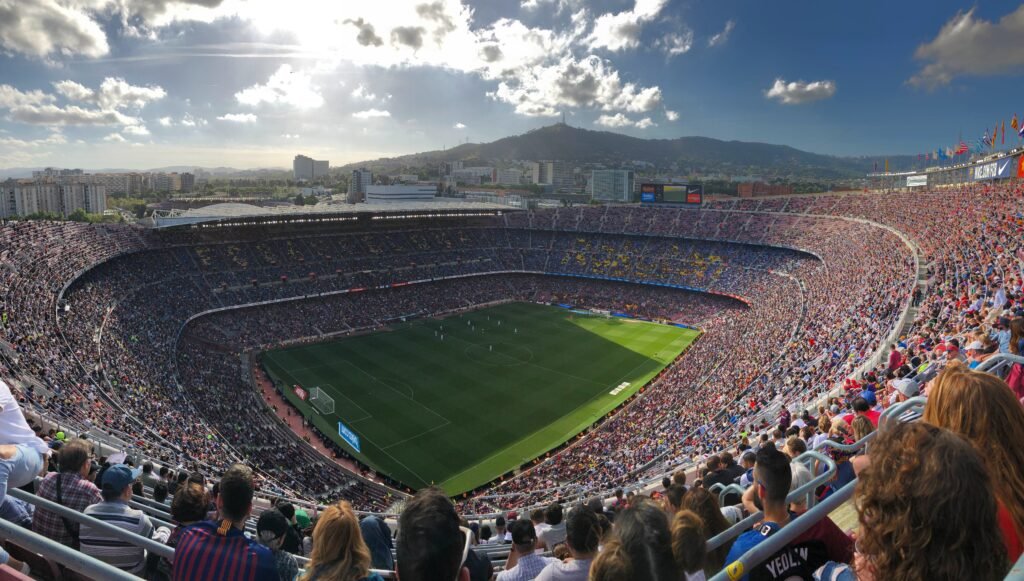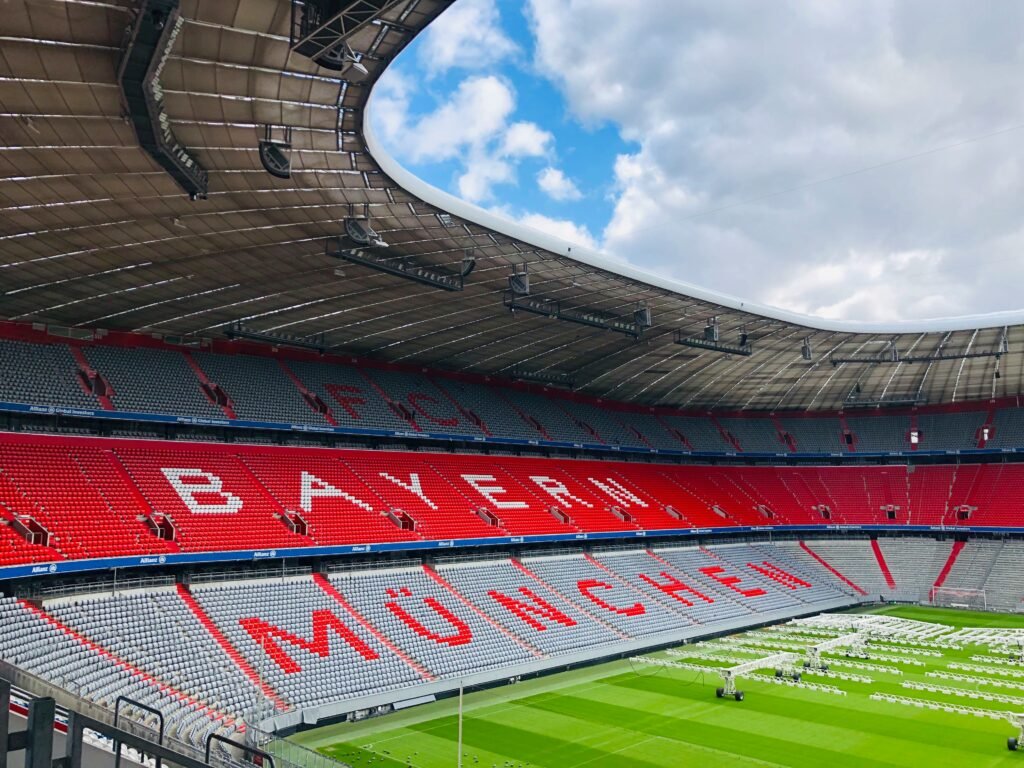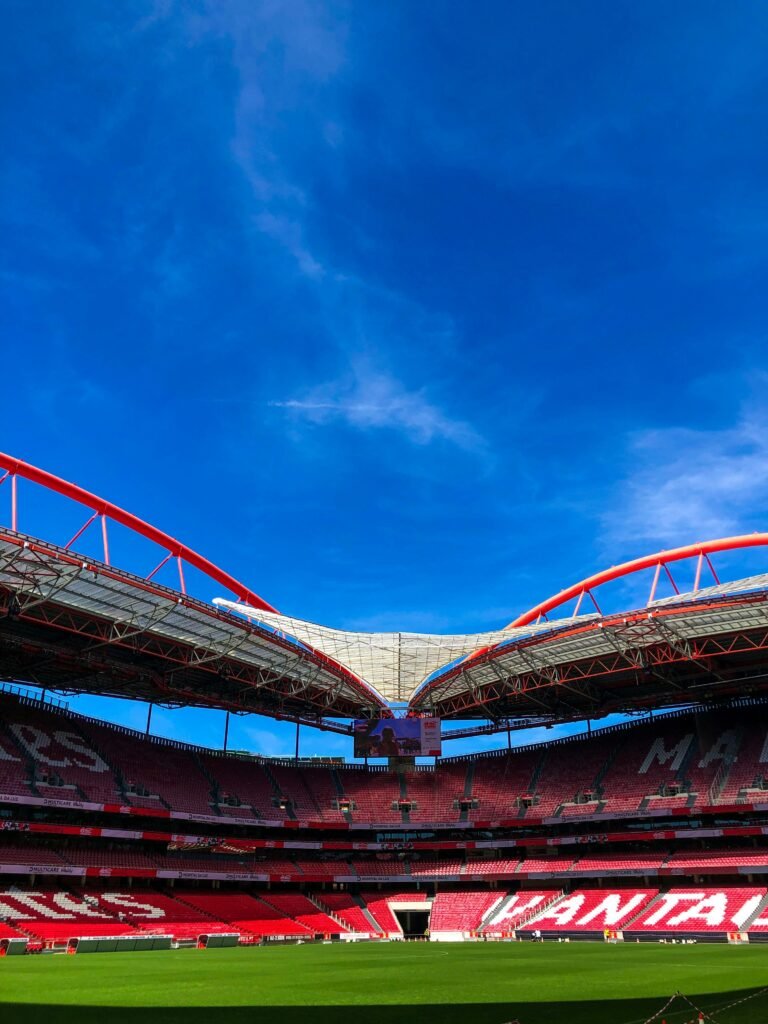The famous football stadiums that can be found all throughout Europe—each with an incredible atmosphere, architectural wonders, and a rich history—are at the center of this obsession. Join us as we set out to explore some of Europe’s most spectacular football stadiums.
1. Barcelona, Spain’s Camp Nou
Camp Nou, the home of FC Barcelona, is more than simply a stadium—it’s a representation of Catalan pride & the best in football. Having more than 99,000 seats, it is the biggest football arena in Europe. With its enormous stands, vivid colors, plus the echo of “Barça” cries echoing through its halls, Camp Nou offers an experience that is unlike any other.

2. Spain’s Santiago Bernabéu in Madrid
Real Madrid’s stronghold, the Santiago Bernabéu, is another treasure from Spain. This stadium, which is well-known for its high stands and thrilling atmosphere, has seen many significant events in football history. The new Bernabéu, which is presently undergoing a big restoration, promised to be even more amazing with its contemporary designs and cutting-edge amenities.

3. Old Trafford, located in Manchester, UK
Manchester United’s famous home, Old Trafford, is located in the center of Manchester. This iconic stadium, rich in legend and tradition, has hosted some of the most famous games in English in the history of football. With a seating capacity of more than 74,000, it is the biggest club football stadium in the United Kingdom.
4. Munich, Germany’s Allianz Arena
The Allianz Arena, which is host to both FC Bayern Munich & TSV 1860 Munich, is a representation of creativity and modernism. Depending on whatever side is playing, its eye-catching exterior, made of inflatable ETFE plastic panels, may change color and illuminate the Munich cityscape in shades of red, blue, or white. It’s an explosive atmosphere inside, especially on Bayern’s legendary European evenings.

5. Liverpool, England’s Anfield
Liverpool FC’s historic home, Anfield, is a place associated with glory and passion. Anfield resonates with a sense of history and friendship unlike any other, from the spine-tingling performance of “You’ll Never Walk Alone” to the iconic Kop stand. The stadium is always growing while maintaining its rich history, as seen by plans for ongoing expansion that include the renovation of the historic Anfield Road stand.
6. Milan, Italy’s San Siro
The San Siro, sometimes called the Stadio Giuseppe Meazza, is a real football shrine owned by AC Milan and Inter Milan. It is impressive to see because of its massive structure and distinctive architectural style. The San Siro, which hosts exciting derbies and European matchups, is still an essential element of Milanese soccer culture even if plans for a new stadium are now underway.
7. Paris, France’s Parc des Princes
Like the city it sits in, the Parc des Princes, home of Paris Saint-Germain, is a symbol of style and elegance.It provides football fans with a first-rate experience with its state-of-the-art amenities and opulent settings. Its popularity has been further heightened by the recent renovations, which have cemented its position as one of Europe’s top football venues.
8. London, England’s Wembley Stadium
Wembley Stadium is a byword for grandeur and history in football. As England’s national stadium, it has played host to a number of landmark games, including finals of the UEFA Champions League and World Cup. Its unique arch has come to represent the London skyline, and its cutting-edge amenities guarantee visitors a top-notch experience.
9. Germany’s Signal Iduna Park, located in Dortmund
Signal Iduna Park, originally Westfalenstadion, is host to Borussia Dortmund and is well-known for its devoted and ardent fan following, which is lovingly referred to as the “Yellow Wall.” The stadium has the biggest standing terrace in European football and an electrifying atmosphere that can terrify even the most experienced opponents.
10. Lisbon, Portugal’s Estádio da Luz
The Estádio da Luz, also known as the Stadium of Light, exudes grandeur and distinction as the home field of SL Benfica.

It has hosted multiple national and international competitions, such as the UEFA Euro 2004 final, thanks to its eye-catching contemporary architecture and seating capacity of more than 64,000. The stadium has a captivating presence, particularly for evening games, thanks to its lit exterior.
FAQs:
1. Which European football stadiums are some of the biggest?
Wembley Stadium in London, Barcelona’s Camp Nou, Madrid’s Santiago Bernabéu, and Dortmund’s Signal Iduna Park are a few of Europe’s biggest football venues.
2. Which stadium attracts the most fervent supporters?
Dortmund, Germany’s Signal Iduna Park is well known for its fervent fan base, especially the “Yellow Wall” section, wherein Borussia Dortmund supporters generate an electrifying environment during games.
3. Do any arenas in Europe have any distinctive architectural elements?
Indeed, a number of stadiums in Europe have distinctive architectural styles. For instance, the Johan Cruyff Arena in Amsterdam is renowned for its creative design and adaptability, while the Allianz Arena in Munich features a stunning exterior composed of expanded ETFE plastic panels which can change color.
4. Which venue has seen the most finals of the UEFA Champions League?
With seven UEFA Champions League finals held at the storied Wembley Stadium in London, the stadium has played host to the most finals of any competition.
5. Does Europe have any stadiums with retractable roofs?
Yes, football stadiums in Europe with movable roofs include the Vodafone Arena in Istanbul, Turkey, and the Mercedes-Benz Arena Stadium in Stuttgart, Germany. These venues offer event organizers flexibility and shield fans from the weather.
To read more, click here